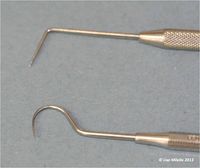Difference between revisions of "Dental Explorer"
Jump to navigation
Jump to search
Fiorecastro (talk | contribs) |
|||
| (11 intermediate revisions by 3 users not shown) | |||
| Line 1: | Line 1: | ||
| − | + | [[File:Explorer probes.jpg|right|200px|thumb|Different examples of explorer probes<small>''© Lisa Milella 2013''</small>]]The dental explorer or probe, a sharp-ended instrument. | |
| − | [[File:Explorer probes.jpg|right|200px|thumb|Different examples of explorer probes<small>''© Lisa Milella 2013''</small>]] | + | <br><br> |
| − | The dental explorer or probe, | + | It is used to check for hard tissue defects for example: |
| − | + | *Determine the presence of caries | |
| − | It is used to check for hard tissue defects | + | *Explore other [[Enamel Organ#Enamel|enamel]] and [[Enamel Organ#Dentin|dentin]] defects, such as fractured teeth, [[FORL|odontoclastic resorptive lesions]] |
| − | * | ||
| − | * | ||
The explorer is also useful for tactile examination of the subgingival tooth surfaces. Subgingival calculus and odontoclastic resorptive lesions may be identified in this way. | The explorer is also useful for tactile examination of the subgingival tooth surfaces. Subgingival calculus and odontoclastic resorptive lesions may be identified in this way. | ||
| − | Dental explorers are available in various shapes, usually straight or curved. The Shepherds hook pattern is frequently used in veterinary dentistry, but a probe with a 90 degree bend is often easier to use, and more | + | Dental explorers are available in various shapes, usually straight or curved. The Shepherds hook pattern is frequently used in veterinary dentistry, but a probe with a 90 degree bend is often easier to use, and more ideal. |
| − | |||
| − | |||
| − | |||
| − | |||
| − | |||
| − | |||
| − | |||
| − | |||
| − | |||
| − | |||
| − | |||
| − | |||
| − | [[Category: | + | [[Category:Dental Instruments]] |
| − | [[Category: | + | [[Category:To Do - Dentistry preMars]] |
Revision as of 16:37, 9 September 2013
The dental explorer or probe, a sharp-ended instrument.
It is used to check for hard tissue defects for example:
- Determine the presence of caries
- Explore other enamel and dentin defects, such as fractured teeth, odontoclastic resorptive lesions
The explorer is also useful for tactile examination of the subgingival tooth surfaces. Subgingival calculus and odontoclastic resorptive lesions may be identified in this way. Dental explorers are available in various shapes, usually straight or curved. The Shepherds hook pattern is frequently used in veterinary dentistry, but a probe with a 90 degree bend is often easier to use, and more ideal.
